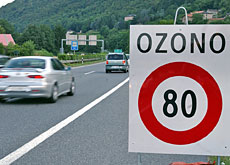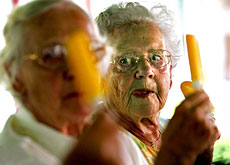Air pollution in 2007 lowest for years

Measurements of air pollution in Switzerland in 2007 showed noticeably lower levels than in previous years, even though limits were often exceeded.
However this was not due to a reduction of harmful emissions but rather the combination of a wet summer and lower than usual levels of winter smog.
“The concentration of ozone and dust particles haven’t been as low as they were in 2007 for five years,” said Rudolf Weber from the Federal Environment Office on Thursday, adding that nitrogen levels were also lower than the previous year.
“Having said that, the limits for pollution were frequently exceeded in 2007,” he admitted.
Weber said the main reason for the low levels of ozone last year was the wet summer.
Summer smog, or photochemical smog, is a brown, oxidising fog mainly made up of ozone. The causes of photochemical smog are nitrogen oxides and so-called volatile organic compounds such as methane, which stem from traffic and industries.
Rain results in a through mixing of the atmospheric layers and washes out harmful substances.
Weber said the lower levels of nitrogen and dust particles on the other hand were down to unusual amounts of winter smog, also referred to as acid smog.
In winter, ground temperatures are sometimes lower than those measured in the upper atmospheric layers. This causes the air to stay near the ground and as a result pollutants do not spread.
Winter smog can form when temperatures are low and sulphur dioxide concentrations increase owing to central heating emissions from houses. The cold outside air helps moisture condensate into fog.
Humidity aids the transformation of sulphur dioxide into sulphuric acid, making the smog acidic and causing breathing problems as well as eye irritations.
More storms
Felix Schacher, a meteorologist from MeteoSwiss, the national weather service, said lengthy periods of smog, fog and mist were rare in 2007 and therefore less likely to be trapped in the lowlands.
Storms on the other hand had been more common, he said. This was a result of the mixing of the atmospheric layers.
Ultimately, Schacher said, wind frequency and strength was the deciding factor in air pollution levels.
It’s a wrap
On Thursday the Swiss transport and environment association, supported by the Swiss Cancer League, highlighted the health risks related to air pollution.
The two partners unveiled their latest action in the heart of Zurich: they have wrapped a tree for 30 days in netting and white flags with the slogan “I am also a lung”.
They say their aim is to draw attention to the continuing pollution of the air by dust particles.
Once the flags have become dirty, they will be handed in to the authorities along with a demand for better air quality.
The harmful effects of inhaling dust particles – caused by diesel emissions from cars among other things – include asthma, lung cancer, cardiovascular issues and premature death.
Larger dust particles are generally filtered in the nose and throat and do not cause problems, but particles smaller than ten micrometres, referred to as PM10, can settle in the bronchi and lungs and cause health problems.
The association says the PM10 limit, agreed by the authorities, is exceeded in many places almost every other day and occasionally by 100 per cent.
The transport and environment association has demanded for some time for particle filters on diesel vehicles.
swissinfo with agencies
Three million people in Switzerland – more than 40% of the population – live in regions that record above-average fine particle levels.
The Federal Environment Office says 21,000 tons of fine dust are emitted in Switzerland every year.
56% comes from the private and public use of mechanical abrasion.
The rest comes from diesel motors (17%), wood burning (15%), other burning (10%) and petrol, natural gas and natural oil (2%).
“Bad” ozone
Ozone is found in the troposphere, which is the lowest region of the atmosphere, extending from the earth’s surface to a height of about 6-10km.
Ozone is not generated directly by human activity, but forms as a result of prolonged exposure to the sun, first of all from nitric oxide and volatile organic compounds (VOC).
The main cause of nitric oxide emission is motorized traffic, whereas industry and households generate VOC.
The effects on humans include irritation of the mucous membranes, inflammation of the respiratory tract, reduction of the lungs’ function and physical performance.
“Good” ozone
Stratospheric ozone is found in the higher regions of the atmosphere and protects us from ultraviolet rays.
Over the past few years, this type of ozone has been reduced considerably (the famous ozone hole), owing to an excessive use of substances such as chlorofluorocarbon (CFC).

In compliance with the JTI standards
More: SWI swissinfo.ch certified by the Journalism Trust Initiative











You can find an overview of ongoing debates with our journalists here . Please join us!
If you want to start a conversation about a topic raised in this article or want to report factual errors, email us at english@swissinfo.ch.